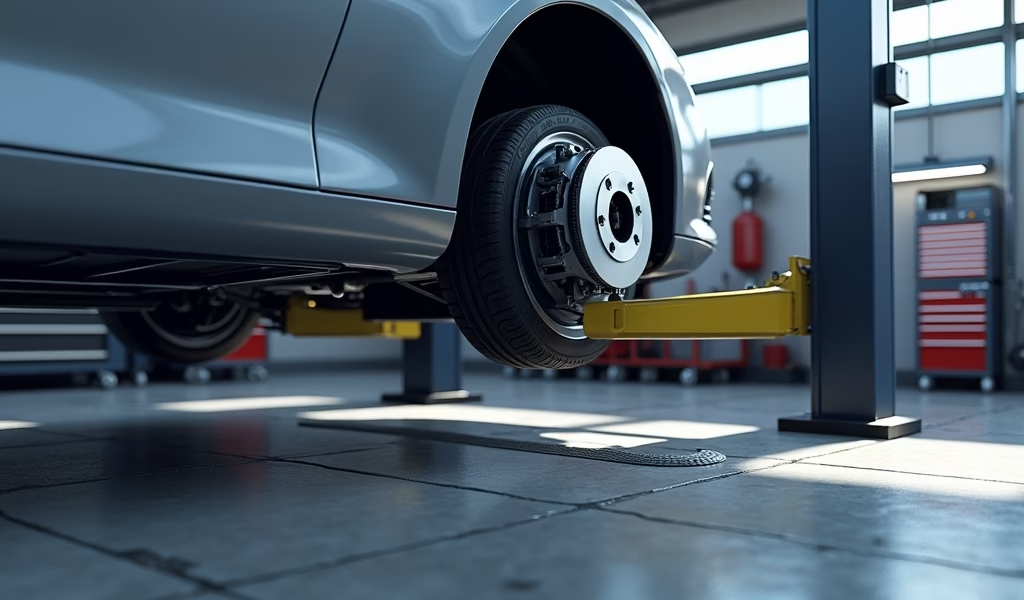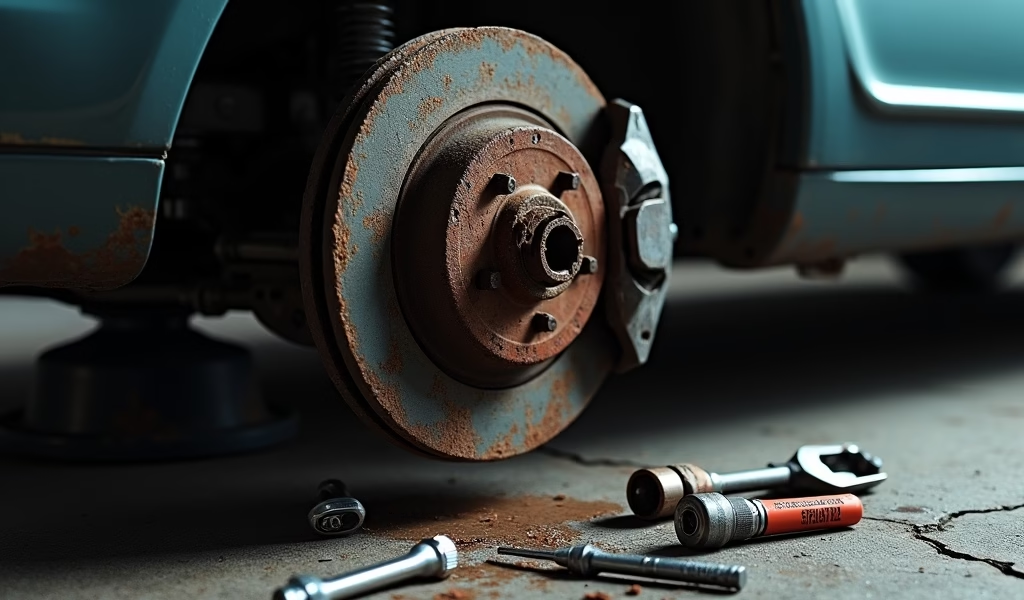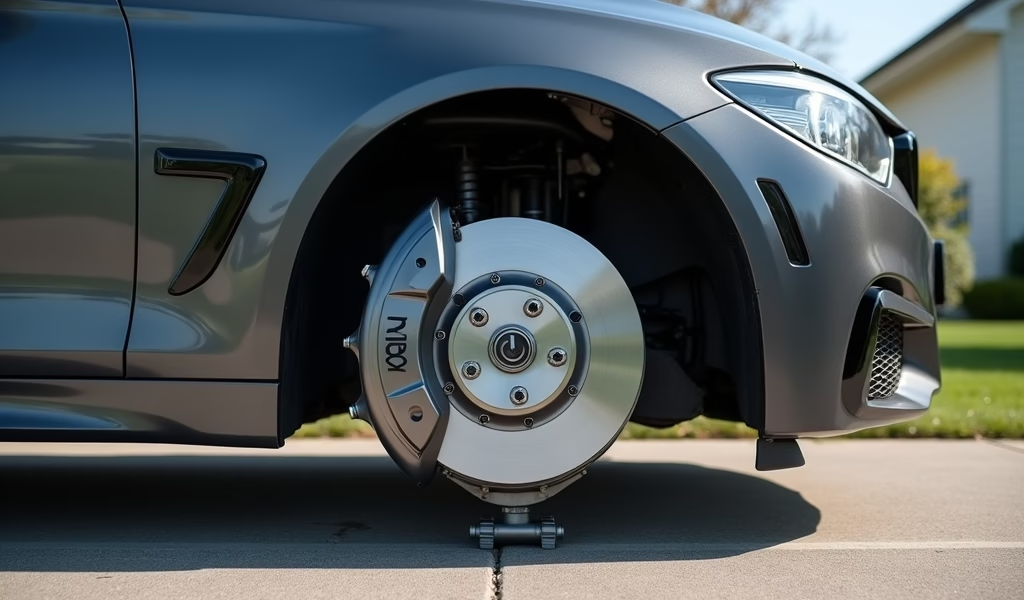Overview
This DIY brake repair guide walks readers through five essential procedures for replacing brake components, including detailed steps for front/rear brake pads and rotors replacement, proper system bleeding, and post-installation testing. The article emphasizes that performing these repairs yourself can save up to 70% on maintenance costs while providing greater control over your vehicle’s most critical safety system.
Table of Contents
- Understanding When Your Brakes Need Replacement
- Essential Tools and Materials You’ll Need
- DIY Fix #1: Replacing Front Brake Pads
- DIY Fix #2: Tackling Rear Brake Pad Replacement
- DIY Fix #3: Front Rotor Replacement Made Simple
- DIY Fix #4: Mastering Rear Rotor Replacement
- DIY Fix #5: Proper Brake System Bleeding
- Post-Replacement Testing and Break-In Period
- Conclusion: Safety and Savings
- Frequently Asked Questions
Let’s face it—there’s nothing quite like that heart-stopping moment when you press your brake pedal and something doesn’t feel quite right. Your vehicle’s braking system isn’t just another maintenance item; it’s your car’s most crucial safety feature and the thin line between a safe stop and potential disaster.
While many folks automatically head to the shop at the first sign of brake issues, the truth is that brake and rotor replacement is one of the most accessible DIY jobs that can save you serious cash. The average professional brake job runs between $300-$800, but tackling it yourself can slash those costs by up to 70%—leaving more money in your pocket for life’s other necessities (or maybe that road trip you’ve been dreaming about).
As a mechanic with 15+ years of experience, I’ve guided countless car owners through their first brake jobs. In this comprehensive guide, I’ll walk you through five essential DIY brake and rotor replacement procedures that any motivated car owner can master, even if you’ve never picked up a wrench before.
Understanding When Your Brakes Need Replacement
Your vehicle has ways of telling you when brake components are crying out for replacement. Think of these signs as your car’s desperate plea for help before things get dangerous.
The most common warning signals include:
- Squealing or grinding noises when braking (the classic “metal-on-metal” sound means you’ve waited too long)
- Vibration or pulsation in the brake pedal (often indicates warped rotors)
- Your vehicle pulls to one side during braking
- Increased stopping distance (when you find yourself pressing harder for the same stopping power)
- Visible scoring or deep grooves on the rotor surface
- Brake warning light illumination on your dashboard
Before jumping into a full replacement, perform a quick inspection. For brake pads, look through the caliper inspection window—you should see at least ¼ inch of pad material. For rotors, check for cracks, severe scoring, or obvious uneven wear. If your rotor looks like the surface of the moon, it’s definitely time for replacement.
Most brake pads need replacement every 30,000-70,000 miles, depending on your driving habits and conditions. City drivers with frequent stops will wear through pads much faster than highway cruisers. According to NHTSA research, regular brake inspections are crucial for maintaining vehicle safety standards.

Essential Tools and Materials You’ll Need
Like any good home improvement project, successful brake and rotor replacement starts with having the right tools on hand. Trust me, there’s nothing more frustrating than getting halfway through the job only to realize you’re missing a crucial tool.
Here’s your essential toolkit:
- Jack and jack stands (never—and I mean never—rely solely on a jack)
- Lug wrench or impact gun for wheel removal
- C-clamp or caliper piston tool
- Socket set and wrenches (check if your vehicle uses metric or standard)
- Torque wrench for proper tightening
- Wire brush for cleaning caliper brackets
- Brake parts cleaner spray
- High-temperature brake grease
Don’t skimp on safety equipment either. You’ll need safety glasses (brake dust is seriously nasty stuff), gloves, wheel chocks, and a well-ventilated workspace. Your lungs and eyes will thank you later.
When it comes to selecting parts, remember that brake pads and rotors replacement cost varies widely based on quality. For most daily drivers, mid-grade components offer the best balance of performance and value. Always buy complete axle sets (both right and left sides) to ensure balanced braking.
DIY Fix #1: Replacing Front Brake Pads
Front brakes handle 60-80% of your vehicle’s stopping power, making them the most common replacement item. The good news? They’re also the easiest to access and replace.
Here’s your step-by-step guide:
1. First, make sure your vehicle is on a level surface. Loosen (but don’t remove) the lug nuts while the wheel is still on the ground.
2. Jack up the vehicle and secure it on jack stands. Remove the wheel completely for full access to the brake assembly.
3. Locate the caliper—it’s the clamp-like component that hugs the rotor. Remove the slide bolts (usually on the back side) that secure it in place. Most vehicles use 13mm, 14mm, or 15mm bolts.
4. Once the bolts are removed, pivot the caliper upward away from the rotor. Never let it hang freely by the brake hose! I typically rest it on top of the rotor or use a piece of wire to hang it from the suspension spring.
5. Remove the old pads from the caliper bracket. Take note of how they’re positioned—the new pads will go in the exact same way.
6. Examine the rotor surface. If it looks reasonably smooth without deep grooves, you can often reuse it. If not, see DIY Fix #3 coming up shortly.
7. Here’s where that C-clamp comes in handy. You’ll need to compress the caliper piston back into its bore to make room for the new, thicker pads. Place the old pad against the piston for protection, then slowly tighten the clamp until the piston is fully retracted.
8. Apply a thin layer of brake grease to the back of the new pads and contact points on the caliper bracket. This prevents squeaking and promotes smoother operation.
9. Install the new pads in the caliper bracket, then carefully pivot the caliper back down over them. Reinstall the caliper bolts and tighten to specification (typically 20-30 ft-lbs, but check your vehicle’s manual).
10. Replace the wheel, lower the vehicle, and torque the lug nuts to specification.
Most DIYers can complete front brake pad replacement in 1-2 hours per side. Before driving, pump the brake pedal several times until it feels firm. This step is crucial—it moves the pistons back into contact with the new pads.
DIY Fix #2: Tackling Rear Brake Pad Replacement
Rear brake replacement follows similar principles to front brakes, but with some important differences that often trip up first-timers. Don’t worry—I’ve got you covered.
The main difference is that many vehicles integrate the parking brake with the rear brakes. This means the caliper piston usually can’t be simply compressed like the front—it needs to be rotated as it’s pushed back.
For rear disc brakes, follow these steps:
1. Follow steps 1-4 from the front brake procedure to remove the wheel and access the caliper.
2. Before removing anything, take a quick photo of how the parking brake mechanism connects. Trust me, this reference photo will save you headaches later.
3. Remove the caliper. Here’s where things get different: instead of just using a C-clamp, you’ll need a caliper piston tool that can rotate the piston while compressing it. These specialized tools have pins that engage with notches in the piston.
4. Turn the tool clockwise while applying pressure to retract the piston. It can take some muscle, but be patient—forcing it can damage the mechanism.
5. Install the new pads, reassemble the caliper, and ensure the parking brake connection is properly restored.
For vehicles with drum brakes in the rear, the process is completely different and involves spring removal tools, adjusters, and more patience. If your vehicle has rear drums, I’d recommend watching a model-specific video before starting.
Vehicle-specific quirks abound with rear brakes. European vehicles often have electronic parking brakes requiring special procedures. Some Asian vehicles use different caliper designs that separate into multiple pieces. When in doubt, consult your service manual or a reputable online guide for your exact make and model.
DIY Fix #3: Front Rotor Replacement Made Simple
Sometimes, brake pad replacement isn’t enough. When rotors are worn beyond their service limits, warped, or damaged, they need to be replaced to restore proper braking performance.
Years ago, mechanics would often “turn” or resurface rotors to extend their life. Today’s rotors are manufactured with tighter tolerances and less extra material, making replacement often more economical than resurfacing. If your rotor is within 0.010″ of the minimum thickness specification (usually stamped on the rotor), replacement is your best bet.
Here’s how to replace front rotors:
1. Complete steps 1-4 from the front brake pad procedure to remove the wheel and caliper.
2. Instead of just pivoting the caliper up, you’ll need to remove it completely along with its bracket. Look for two larger bolts (typically 17mm or 19mm) that attach the bracket to the steering knuckle.
3. Once the bracket and caliper are removed (keep them together and set aside safely), the rotor should be exposed and ready for removal.
4. Some rotors simply slide off the hub, while others might be held on with a small retaining screw (often Phillips or Torx head). Remove any retaining screws.
5. If the rotor seems stuck, try tapping it gently with a rubber mallet around the center hub. Years of corrosion can make them stubborn!
6. Once removed, clean the hub surface thoroughly with a wire brush. Any rust or debris left between the hub and new rotor can cause vibration or uneven wear.
7. Compare your new rotor to the old one to ensure they match in size and configuration.
8. Install the new rotor onto the hub, replace any retaining screws, then reinstall the bracket and caliper assembly.
9. Continue with the pad replacement procedure described earlier.
A few critical checks before you button everything up: ensure the rotor sits flush against the hub with no wobble, verify that all bolts are properly torqued, and confirm the rotor spins freely without contact to the bracket.

DIY Fix #4: Mastering Rear Rotor Replacement
Rear rotors face unique challenges, especially with integrated parking brake systems or the increasingly common “drum-in-hat” designs that combine a disc brake with a drum parking brake.
Let me walk you through the process:
1. Follow the rear brake pad replacement steps to remove the caliper and bracket.
2. Ensure the parking brake is fully released—this is crucial! A partially engaged parking brake will prevent rotor removal.
3. Remove any retaining screws holding the rotor to the hub (common on many Japanese vehicles).
4. Remove the rotor, which often requires more persuasion than front rotors due to corrosion and less frequent use. A rubber mallet and some penetrating oil might become your best friends here.
5. For drum-in-hat designs, take a moment to inspect the parking brake shoes inside the “hat” portion of the rotor. If they’re worn or contaminated with brake fluid, now’s the perfect time to replace them.
6. Clean the hub surface thoroughly and check for damaged wheel studs.
7. Install the new rotor, being mindful of any directional indicators. Some rear rotors are side-specific, marked with “L” and “R” for left and right.
8. Reinstall the bracket, caliper, and pads, then adjust the parking brake if necessary (consult your vehicle’s service manual for the specific procedure).
Pro tip: Apply a thin coat of anti-seize compound to the hub center where the rotor mounts. This small step will make your future self very grateful when it’s time for the next replacement.
Remember that brake pads and rotors replacement cost is significantly reduced when you handle rear rotors yourself. What might cost $300-500 at a shop can be done for the cost of parts—typically $80-150 for quality rear rotors and pads.
DIY Fix #5: Proper Brake System Bleeding
After replacing brake components, particularly if you’ve opened the hydraulic system, bleeding the brakes is essential to remove air bubbles. Air in your brake lines creates a spongy pedal and reduced braking efficiency—definitely not something you want to discover when you need to stop quickly.
Brake fluid is hygroscopic, meaning it absorbs moisture over time. This moisture lowers the fluid’s boiling point and introduces corrosion into the system. Regular bleeding (every 2-3 years) replaces old, contaminated fluid while removing performance-robbing air bubbles.
There are several bleeding methods, each with pros and cons:
- Gravity bleeding: Simply open bleeder screws and let gravity push fluid through (slow but effective for one person)
- Pressure bleeding: Uses a pressurized tool connected to the master cylinder (fastest and most efficient)
- Vacuum bleeding: Applies vacuum at bleeder screws to draw fluid through (good for one-person operation)
- Manual two-person bleeding: The traditional method where one person pumps the pedal while another opens/closes bleeder screws
For most DIYers, the manual two-person method works perfectly well:
1. Check your vehicle’s bleeding sequence (typically starts with the brake furthest from the master cylinder, usually the right rear).
2. Fill the master cylinder with fresh fluid of the correct type (DOT 3, DOT 4, etc. as specified in your owner’s manual).
3. Have a helper sit in the driver’s seat and pump the brake pedal 3-4 times, then hold firm pressure.
4. While they maintain pressure, open the bleeder screw with a wrench (usually 8mm or 10mm). Fluid and air bubbles will escape.
5. Close the bleeder screw before your helper releases the pedal.
6. Repeat steps 3-5 until clear, bubble-free fluid flows from the bleeder screw.
7. Move to the next brake in sequence (typically left rear, then right front, then left front).
8. Check master cylinder fluid level frequently during bleeding—running it dry will introduce more air into the system.
When complete, the brake pedal should feel firm and responsive. If it still feels spongy, you likely have air remaining in the system and need to repeat the bleeding process. According to safety experts, proper brake system bleeding is essential for maintaining optimal stopping power.
Post-Replacement Testing and Break-In Period
Your brake job isn’t complete until you’ve properly tested and broken in your new components. This crucial step ensures optimal performance and longevity.
Before hitting the open road, perform these safety checks:
- Check for proper pedal feel (firm, not spongy)
- Ensure the vehicle doesn’t pull to either side during gentle stops
- Listen for unusual noises
- Verify all wheels turn freely when brakes aren’t applied
- Check for leaks around calipers and connections
New brake components need a proper break-in period. This process transfers a thin layer of pad material onto the rotor surface, creating the optimal friction interface. Here’s how to do it right:
1. Find a safe, low-traffic area and make 8-10 moderate stops from 30 mph, allowing about 30 seconds between stops for cooling.
2. Avoid hard stops during the first 200-300 miles.
3. If possible, avoid prolonged stops (like sitting in traffic with your foot on the brake) during the first week.
Watch for warning signs that something’s wrong: continued squealing or grinding, vibration during braking, pulling to one side, soft pedal feel, or a burning smell. Any of these symptoms warrants immediate inspection before continuing to drive.
A proper break-in ensures even pad material transfer and prevents “glazing” of pads or rotors. Many professional mechanics recommend following manufacturer-specific break-in procedures for optimal results, especially with higher-performance brake components.
Conclusion: Safety and Savings
Mastering brake and rotor replacement puts you in control of one of your vehicle’s most critical safety systems. Beyond the substantial cost savings—potentially thousands over your vehicle’s lifetime—DIY brake work provides peace of mind that comes from knowing exactly how your vehicle was serviced and with what quality of parts.
Regular brake inspection should become part of your maintenance routine, with checks every 10,000 miles or during tire rotations. This preventative approach helps you catch wear before it becomes a safety issue and gives you time to plan your DIY job rather than facing an emergency repair.
While these DIY procedures are within reach of most motivated car owners, it’s important to recognize your limitations. If you encounter significant rust, seized components, or hydraulic leaks, seeking professional assistance may be the wisest course. Sometimes, the right DIY decision is knowing when to call in the experts.
Remember, your braking system isn’t just about stopping—it’s about stopping safely, predictably, and reliably through all driving conditions. Give it the attention it deserves, and it will serve you faithfully mile after mile.
Frequently Asked Questions
How do I know if I need new rotors or just brake pads?
Check rotors for deep grooves, cracks, or significant lip formation around the edge. If your brake pedal pulsates during stopping or the rotor thickness is near minimum specification, replacement is recommended.
How long do brake pads and rotors typically last?
Brake pads generally last 30,000-70,000 miles depending on driving habits and conditions. Rotors typically last through 2-3 pad replacements but should be measured during each pad change.
Is it necessary to replace rotors in pairs?
Yes, always replace rotors in pairs (both front or both rear) even if only one shows significant wear. Replacing in pairs ensures balanced braking performance and even wear.
Can I replace just the brake pads without replacing the rotors?
Yes, if the rotors are within specification and show minimal wear, you can replace just the pads. However, resurfacing or replacing rotors with each pad change often provides better braking performance.
How much money can I save by doing my own brake job?
DIY brake jobs typically save 50-70% compared to shop prices. A complete brake job that might cost $600-800 at a shop can often be done for $150-300 in parts when done yourself.

